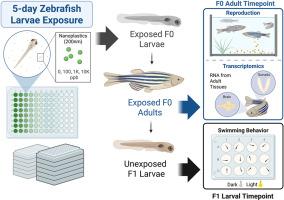斑马鱼(Danio rerio)在发育过程中暴露于聚苯乙烯纳米塑料的不良成年发病和多代效应
IF 7.3
2区 环境科学与生态学
Q1 ENVIRONMENTAL SCIENCES
引用次数: 0
摘要
微塑料(MP)和纳米塑料(NP)污染已经渗透到地球上生命的几乎所有方面——从高空云层和北极冰芯到单细胞藻类和未出生的胎儿。与MPs相比,NPs渗透血脑、睾丸等生物屏障的能力关系到人类健康。在人体组织中积累的证据已经积累起来,但长期健康后果尚未得到很好的了解。在此之前,我们将斑马鱼幼体暴露于环境相关剂量的NP(0 - 10亿分之1万)中5天,报告了NP积累、过度活跃以及暴露后神经肌肉、代谢和表观遗传途径的破坏。在这里,我们将这些发育暴露的动物饲养到成年,评估生殖能力,后代神经行为,以及大脑和性腺组织的转录组学进行比较。NP暴露会损害成年期的生殖能力:高水平暴露会大大降低总体产卵能力,中等水平暴露也会降低受精卵的受精率。中间组幸存下来的后代也像他们的父母一样过度活跃,表现出持久和可遗传的神经行为表型。总体而言,成虫组织中差异表达的基因远比幼虫组织中差异表达的基因显著;然而,幼虫的内分泌和神经疾病途径的破坏持续到成年。虽然女性转录组学表明从早期NP暴露中恢复,但男性组织受到有害且不成比例的影响。男性转录组学涉及神经肌肉和神经退行性疾病、内分泌紊乱和癌症。氧化应激是一个持续存在的机制,潜在的持续破坏和成人发病的病理。本文章由计算机程序翻译,如有差异,请以英文原文为准。

Adverse adult-onset and multigenerational effects in zebrafish (Danio rerio) developmentally exposed to polystyrene nanoplastics
Microplastic (MP) and nanoplastic (NP) pollution has permeated virtually all aspects of life on earth – from high altitude clouds and arctic ice cores to single celled algae and unborn fetuses. Compared to MPs, the ability of NPs to infiltrate biological barriers such as the blood-brain and testes barriers is concerning to human health. Evidence of accumulation across human tissues has accrued, but the long-term health consequences are not well understood. Previously, we exposed zebrafish larvae to environmentally relevant doses of NPs (0 –10,000 parts per billion) for five days during early development, reporting NP accumulation, hyperactivity, and disruption of neuromuscular, metabolic, and epigenetic pathways immediately post-exposure. Here, we reared these developmentally exposed animals to adulthood, assessing reproductive capacity, offspring neurobehavior, and transcriptomics of brain and gonadal tissue for comparison. NP exposure impaired reproduction in adulthood: while high level exposure profoundly reduced overall spawning capacity, intermediate exposure also decreased fertilization of elicited eggs. Surviving offspring from the intermediate group were also hyperactive, like their parents, demonstrating a persistent and heritable neurobehavioral phenotype. Overall, far more significantly differentially expressed genes were found in adult tissues than in larvae; however, larval disruption of endocrine and neurological disease pathways persisted into adulthood. While female transcriptomics suggested recovery from early life NP exposure, male tissues were deleteriously and disproportionately affected. Male transcriptomics implicated neuromuscular and neurodegenerative diseases, endocrine disruption, and cancer. Oxidative stress was a consistently present mechanism underlying persistent disruption and adult-onset pathologies.
求助全文
通过发布文献求助,成功后即可免费获取论文全文。
去求助
来源期刊

Environmental Pollution
环境科学-环境科学
CiteScore
16.00
自引率
6.70%
发文量
2082
审稿时长
2.9 months
期刊介绍:
Environmental Pollution is an international peer-reviewed journal that publishes high-quality research papers and review articles covering all aspects of environmental pollution and its impacts on ecosystems and human health.
Subject areas include, but are not limited to:
• Sources and occurrences of pollutants that are clearly defined and measured in environmental compartments, food and food-related items, and human bodies;
• Interlinks between contaminant exposure and biological, ecological, and human health effects, including those of climate change;
• Contaminants of emerging concerns (including but not limited to antibiotic resistant microorganisms or genes, microplastics/nanoplastics, electronic wastes, light, and noise) and/or their biological, ecological, or human health effects;
• Laboratory and field studies on the remediation/mitigation of environmental pollution via new techniques and with clear links to biological, ecological, or human health effects;
• Modeling of pollution processes, patterns, or trends that is of clear environmental and/or human health interest;
• New techniques that measure and examine environmental occurrences, transport, behavior, and effects of pollutants within the environment or the laboratory, provided that they can be clearly used to address problems within regional or global environmental compartments.
 求助内容:
求助内容: 应助结果提醒方式:
应助结果提醒方式:


